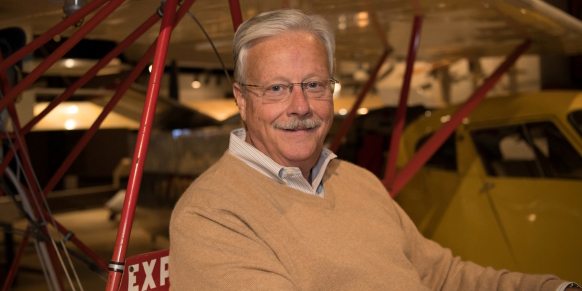EAA Envisions a MOSAIC to Benefit All of GA
By Jack J. Pelton, CEO/Chairman of the Board, EAA
October 18, 2018 - In 2013, EAA helped create a portion of the Part 23 aircraft certification reform aimed at supporting the general aviation legacy fleet. The proposal was known as the Primary Non-Commercial Category and was among the final recommendations coming out of the process, but unfortunately was never adopted within the final rulemaking. With your best interests in mind, it was time to refocus on how EAA could continue to advocate and push forward change that would benefit an even wider segment of our membership, and, specifically, the amateur-built and light-sport categories.
Fast forward three years to the fall of 2016 when Sean Elliott, EAA’s vice president of advocacy and safety, and myself met with the FAA’s Small Airplane Directorate in Kansas City, Missouri, to brainstorm concepts that eventually formed the foundation of FAA’s MOSAIC, or the Modernization of Special Airworthiness Certificates (formerly known as Permit to Fly). During these meetings nearly two years ago, EAA was the first to comprehensively explore modifications that would help the light-sport category reach its full potential and further build on the successes of the amateur-built regulations that EAA has been championing for decades.
That Kansas City meeting was indicative of how EAA has led the way advocating for major change in recreational aviation since Paul Poberezny started going to Washington, D.C., in the 1950s to set in motion development of the homebuilt rules that still benefit us today. Our conversation with the FAA squarely focused on problems and solutions to help all of us. We didn’t wait for a blue-ribbon commission or a 300-page report. Instead, as we’ve always done, we focused on how we can continue to make reform even stronger and more advantageous for our membership.
MOSAIC has effectively emerged from those conversations and evolved into proposals that encompass improvement for a broad spectrum of personal-use flying: LSAs, amateur-builts, sport pilot privileges, and even the vast legacy GA fleet. EAA has continually engaged with FAA officials by regularly visiting Washington, discussing it annually during our distinctive EAA/FAA Winter Aviation Summit in Oshkosh, and showcasing the potential enhancements to senior FAA management during EAA AirVenture Oshkosh. As a result of EAA’s efforts, the FAA fully understands the potential of MOSAIC and has even stated its strategic importance in their rulemaking process.
As MOSAIC has evolved over the past year, a key focus has been on developing performance-based metrics for LSA instead of isolating weight as a sole determinant for reform. These inclusions would consider larger aircraft, as well as better aircraft handling, durability, and performance. It also means more options for the flight training community where many smaller operations are relying on 40- and 50-year-old airframes that don’t showcase the technology available for student pilots today. Who wouldn’t want to learn in newer and more modernized aircraft if given the choice?
Much has been focused recently on the 3,600-pound maximum weight, but that was just one idea brought forward. Ultimately, the emphasis should not be fixated on a number, but rather on how LSA can meet its full potential within performance- and risk-based definitions. EAA wants to ensure the best possible outcome for the personal and flight training markets.
In the amateur-built area, MOSAIC provides additional options such as expanded commercial assistance or fully demand-built aircraft. It also includes policy for warbirds, unique aircraft such as manned multicopters, more flexible risk-based operating privileges, repairman certificates for second owners of homebuilts, as well as other refinements. Let me also make this clear — EAA is absolutely adamant that the 51 percent rules that have made amateur-built aircraft the most active area of new GA aircraft construction will remain unchanged.
MOSAIC would also open opportunities for modernizing legacy GA aircraft built years ago under CAR 3 and Part 23 and would open simplified access to modern safety-enhancing equipment and avionics not previously available or affordable. EAA pioneered this certification approach using the STC process several years ago that has now reached across the avionics spectrum. MOSAIC will continue to build on this by simplifying maintenance, parts eligibility, and modification and alteration guidelines to mirror the success established in the amateur-built world.
This proposal has the potential to be the broadest reform for general aviation in decades. It will make a significant difference. EAA is uniquely positioned to bring this forward with the FAA because our organization has the broad technical expertise and ability to advance a safety-driven agenda. Our approach has been historically successful in accomplishing certification reform in all areas of recreational aviation.
The FAA has projected early 2019 to begin formal rulemaking drafting for MOSAIC. It’s likely we won’t see an NPRM (notice of proposed rulemaking) for comment for up to a year or more after this begins. This is not a fast process for a reason — it’s important to ensure all possibilities are carefully considered. As we know from flying, rushing a process often sets off an unanticipated chain of bad outcomes.
I’m extremely excited about the potential of MOSAIC, and am very proud of EAA’s leadership role in this effort. It’s amazing what can come about from just a casual conversation combined with hard work and a constant focus on results that matter to you.

